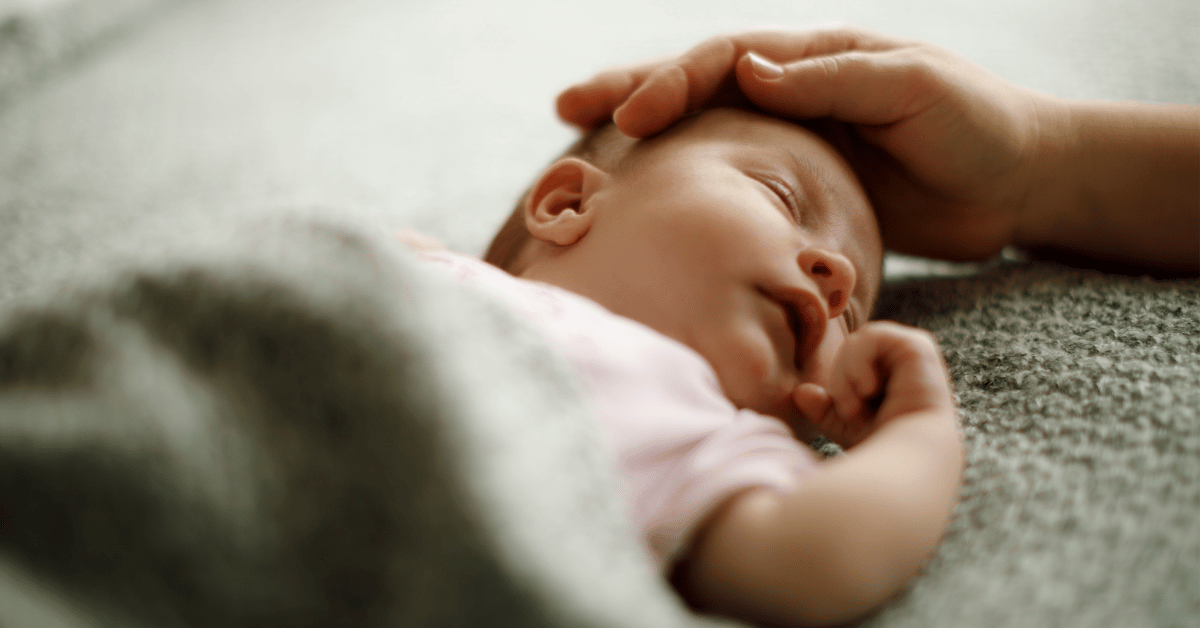The arrival of a newborn brings boundless joy and a flurry of responsibilities for new parents. One of the most crucial aspects of caring for an infant is ensuring they get a good night's sleep in a safe environment.
Safe sleep practices not only contribute to the baby's well-being but also offer peace of mind for parents which is why we created a safe sleep guide for infants.
In this article we will explore the benefits of good sleep, talk about the best safe sleep practices and how you can create a comfortable sleep space for your newborn.
Importance of Sleep
Babies love to sleep! Unaware of the day or night difference, newborns could spend about 12-16 hours just sleeping and will wake up only for feedings and little bit of playtime or interaction with their caregivers.
The influence of sleep on babies is profound and multifaceted, encompassing various aspects of their physical, cognitive, and emotional development. Babies who experience regular, quality sleep are likely to be happier, healthier, and more adaptable.
Understanding the impact of sleep on infants is crucial for parents and caregivers to ensure optimal well-being.

How Sleep Significantly Affects Babies
-
Physical Growth:
Sleep plays a vital role in a baby's physical development. Adequate sleep contributes to healthy weight gain and overall growth.
-
Cognitive Development:
Sleep is closely linked to cognitive functions such as memory consolidation and learning.
Babies who get sufficient sleep are more likely to exhibit better attention spans and enhanced problem-solving skills.
Immune System Support:
Quality sleep is crucial for a robust immune system. Babies with consistent, restful sleep are better equipped to fight off infections and illnesses.
Behavioral Patterns:
Sleep has a significant impact on behavioral patterns in infants. Lack of sleep can lead to moodiness, irritability, fussiness, and difficulty in self-soothing. Establishing healthy sleep routines can contribute to more predictable and positive behavior.

-
Neurological Development:
During sleep, the brain processes and consolidates information acquired throughout the day. Sleep supports the formation of neural connections that are foundational for future cognitive abilities.
-
Regulation of Metabolism:
Sleep is linked to metabolic processes, and disruptions in sleep patterns can affect hunger and satiety cues in babies. Adequate sleep contributes to a healthier metabolism, reducing the risk of obesity-related issues.
-
Sensory Processing:
Babies rely on sleep for the integration of sensory information. Proper sleep supports the development of sensory processing systems. Sensory experiences during wakefulness are better processed and understood after a good night's sleep.
Now that we know how vital sleep is to the overall well-being of a baby, let us take a few moments to learn what's the biggest risk to a good sleep.
What is SIDS?
Sudden Infant Death Syndrome or SIDS is the sudden death of a baby younger than 1 year old that cannot be explained even after a full investigation including an autopsy, a death scene investigation, and a review of the clinical history. It's also known as crib death because infants often die in their cribs when these fatal sleep accidents occur.
Sudden Infant Death Syndrome (SIDS) falls within a broader classification known as Sudden Unexpected Death in Infancy (SUDI), which encompasses infant deaths that occur suddenly with no apparent cause. In cases where the causes of death are later identified, such as brain abnormalities, cardiac dysfunction, and so forth, the incidents are also classified under SUDI.
Risk factors for SIDS:
Here are the most common risk factors for SIDS:
Putting baby to sleep on his side or stomach rather than on his back
Premature or low birth weight babies
baby gets overheated, suffocated, or dehydrated
Letting the baby sleep with loose and weighted blankets, sleepers, swaddles, stuffed animals, and bumper pads
Family history of failure to thrive
The Safe Sleep for Babies Act bans crib bumpers and inclined infant sleepers with an incline of 10 degrees or more. Both these products have been responsible for at least a couple hundred infant deaths. Signed into law by President Joe Biden, the act went into effect on November 12, 2022.

Safe Sleep Guide for Infants
By following these guidelines, you can ensure that your little one enjoys a restful sleep while minimizing the risks associated with SIDS. Here are some safe sleep practices to ensure your baby gets the best sleep without the risk:
Choose the Right Crib:
When selecting a crib, ensure it meets safety standards. Check for any recalls on the crib, and especially avoid buying vintage cribs that may not meet the current safety regulations.
Ensure the mattress is firm and securely fitted to prevent any possibility of the baby becoming trapped between the mattress and the crib.
Check for any missing, loose, or broken screws, brackets, missing or cracked slats or other hardware on the crib to maintain its structural integrity.
The space between crib slats should not exceed 2 3/8 inches.
Keep corner posts under 1/16th inch high to eliminate the risk of a baby's clothing getting caught.
Avoid cribs with cutouts in the headboard or footboard to prevent the baby's head from getting trapped.
Incorrectly assembled cribs or those with missing, loose, or broken hardware, as well as broken slats, can lead to entrapment or suffocation deaths. Gaps created by such issues may result in infants becoming entangled or strangled.
Ensure the paint on the crib is non-toxic and that it does not peel off or flake.
Note: Don’t let your baby fall asleep on a product that isn’t specifically designed for sleeping babies, such as a car seat, lounger, or a boppy pillow.
Say No to Loose Bedding:
We would all love to set our baby's bed in a designer like fashion. However, to reduce the risk of suffocation, avoid using soft bedding with bumper pads, comforters, quilts, pillows, and plush toys for the baby.
There should be nothing on the bed except a fitted sheet on the crib mattress. It is okay to swaddle your baby, dress him in season appropriate clothes, or put a wearable blanket or sleep sack which is a safer alternative to keep your baby warm without the need for loose bedding or extra clothes.
Place Baby on Their Back to Sleep:
The American Academy of Pediatrics (AAP) recommends placing infants on their backs to sleep as the safest sleep position. This position significantly reduces the risk of sudden infant death syndrome (SIDS).
Room Sharing without Bed Sharing
While it's recommended for infants to sleep in the same room as their parents, bed sharing or co-sleeping is not advised. Instead, opt for a separate sleep surface, such as a bassinet or crib, placed near the parent's bed. Sharing a room with the baby also simplifies tasks like feeding, comforting, and keeping an eye on the little one.
Avoid Overheating:
Overheating can be a risk factor for SIDS. You do not want to dehydrate a baby. Dress your baby in light layers and adjust the room temperature accordingly. Use a fan to circulate air, if needed.
Regular Mattress Checkups:
Regularly inspect the crib mattress for any signs of wear or damage. A well-maintained mattress provides a safer sleep surface for your baby.

Creating a Safe Sleep Environment
Creating a safe sleep environment is a fundamental aspect of infant care.
Elements of a safe and comfortable sleeping space:
-
Crib: Choose a crib that passes all the safety checks.
Ensure that the crib mattress fits the crib perfectly.
Use a fitted crib sheet.
Make sure the crib has nothing on it except for the baby.
-
Light: Creating light and dark room environments is key to establishing day and night time routines.
Having light during the day while your child naps, and closing all shades or turning lights off (except for a small night light) can become effective cues that teach your baby the difference between day and night.
-
White Noise Machine: White noise machines have been gaining a lot of popularity and with good reason. They sort of mimic the sounds of the womb thereby creating a comfortable environment that calms infants, and soothes them into falling asleep.
As with any sleep aid, it's essential to use white noise machines in a manner that is comfortable and conducive to restful sleep.
It's important to note that while many babies benefit from white noise, individual preferences vary. Some may prefer nature sounds or other ambient sounds.
Parents should monitor their baby's response to white noise and adjust the volume and type of sound accordingly.
Additionally, ensuring that the white noise machine is placed at a safe distance from the baby's crib and following safe sleep guidelines is crucial.
-
Ventilation: Newborns are delicate and react strongly to any changes in their environment.
To create a safe sleep conducive setting, make sure that the room has proper air circulation.
Keep the room at a comfortable temperature, not too hot or too cold.
Dress your baby in appropriate sleepwear.
Over-bundling your baby is never a good idea.
Also, ensure that there is no one smoking around the baby at all times.
Remember, every baby is unique, so it's essential to stay informed, trust your instincts, and consult with healthcare professionals if you have any concerns about safe sleeping guidelines.
Wishing your little one sweet dreams!
What are the key guidelines for creating a safe sleep environment for infants?
To ensure a safe sleep environment for infants, adhere to these critical guidelines: Choose a crib that meets current safety standards and use a firm mattress with a fitted sheet. Avoid loose bedding and keep soft objects like toys and pillows out of the crib. Always place the baby on their back to sleep, and consider room sharing without bed sharing to keep the baby close but on a separate surface. Additionally, maintain a comfortable room temperature to prevent overheating.
What is the safest sleep position for my baby to reduce the risk of SIDS?
The American Academy of Pediatrics (AAP) recommends placing babies on their backs to sleep for every sleep, naps and night-time alike. This position has been shown to significantly reduce the risk of Sudden Infant Death Syndrome (SIDS) compared to side or stomach sleeping positions.
Can you explain the difference between SIDS and SUDI, and how can I minimize the risk for my baby?
Sudden Infant Death Syndrome (SIDS) is the unexplained death of a baby younger than one year old, typically occurring during sleep. Sudden Unexpected Death in Infancy (SUDI) is a broader term that includes all sudden and unexpected deaths in infancy, including those where a cause is found upon further investigation. To minimize the risk, follow safe sleep practices such as using a safe crib and mattress, avoiding soft bedding, placing your baby on their back to sleep, ensuring the baby doesn't overheat, and keeping the sleeping environment smoke-free.
What are some effective strategies to ensure my baby doesn't overheat during sleep?
To prevent overheating, dress your baby in light, breathable layers, and use a sleep sack or wearable blanket as a safer alternative to loose blankets. Keep the room at a comfortable temperature (around 68-72°F or 20-22°C), and avoid placing the crib near radiators, heaters, or in direct sunlight. Monitoring your baby for signs of overheating, such as sweating or feeling hot to the touch, can also help maintain a safe sleeping temperature.
How can white noise machines benefit my baby's sleep, and are there any precautions I should take when using them?
White noise machines can benefit babies by mimicking the sounds of the womb, providing a soothing backdrop that can help them fall asleep more easily and stay asleep longer. However, it's important to use them safely by keeping the volume at a low to moderate level and placing the machine at least 7 feet (about 2 meters) away from the baby's crib to prevent any potential hearing damage. Additionally, vary the sounds and use the machine judiciously to avoid over-reliance.







